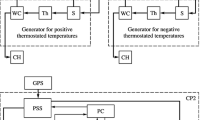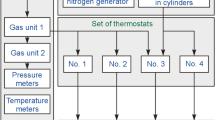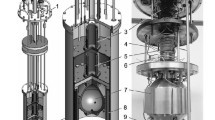The measurement methods and instrumentation for the national primary standard for the units of relative humidity of gases, molar (volume) fraction, and temperature of the dew point, GET 151-2014, are discussed. The structure of the standard is described. The metrological characteristics of the standard and the results of the international key comparisons CCT-K6 are reported.


Similar content being viewed by others
References
O. I. Gudkov, N. I. Dubovikov, and O. A. Podmurnaya, Humid Nitrogen. Excess Coefficients for Temperatures of 283–323 K and Pressures of 0.1–10.0 MPa. Tables of Standard Handbook Data. GSSSD 207-2004, Deposited Manuscript, No. 808-04kk, VNIITsSMV, May 25, 2004.
BS 1339-1:2002, Humidity – Part 1: Terms: Definitions and Formulae.
RMG 75-2014, GSI. Measurements of Humidity of Substances. Terms and Definitions. Recommendations for Intergovernmental Standardization.
K. Kostyrko, “Standard sorption-gravimetric hygrometer,” Izmer. Tekhn., No. 11, 83–86 (1976).
P. Huang, NIST Calibration Services for Humidity Measurements, NISTIR 4677-A (1999).
N. I. Dubovikov, O. A. Podmurnaya, N. P. Skryabikov, et al., “The Russian national standard of gases humidity and traceability system of humidity measurements,” in: TEMPMEKO & ISHM 2010: Book of Abstracts, Portoroz, Slovenia (2010).
M. A. Vinge and I. N. Lazovik, “Improvement of GET 151-2010 to extend the range of dew-point temperatures,” in: Abstr. Int. Conf. Metrologiya-2014, BelGIM, Minsk (2014).
M. Stevens, “The new NPL low frost-point generator,” Meas. Sci. Technol., No. 3, 943–952 (1992).
GOST R 8.811-2012, GSI. Psychrometric Tables. Construction, Content, Computational Relations.
D. Sonntag, “Important new values of the physical constants of 1986. Vapor pressure formulations based on the ITS-90 and psychrometric formulae,” Zeitschr. für Meteorol., No. 40 (5), 340–344 (1990).
O. A. Podmurnaya, Study of the Conditions for Phase Equilibrium of a Nitrogen–Water Thermodynamic System at Pressures up to 10 MPa and Temperatures up to +50°C: Auth. Abstr. Dissert. Cand. Phys.-Math. Sci., Irkutsk (2003).
N. I. Dubovikov, I. A. Sokov, and O. A. Podmurnaya, “Metrological capabilities of a humid gas generator based on the two-pressure method,” Izmer. Tekhn., No. 7, 55–56 (1985).
S. Bell, M. Stevens, H. Abe, et al., Final Report to the CCT on Key Comparison CCT-K6 – Comparison of Local Realisations of Dew-Point Temperature Scales in the Range –50°C to +20°C, NPL, London.
Author information
Authors and Affiliations
Corresponding author
Additional information
Translated from Izmeritel’naya Tekhnika, No. 7, pp. 3–8, July, 2016.
Rights and permissions
About this article
Cite this article
Vinge, A.F., Vinge, M.A., Egorov, V.N. et al. National Primary Standard for the Units of Relative Humidity of Gases, Molar (Volume) Fraction of Moisture, and Dew/Frost Point Temperature, Get 151-2014. Meas Tech 59, 685–692 (2016). https://doi.org/10.1007/s11018-016-1031-0
Published:
Issue Date:
DOI: https://doi.org/10.1007/s11018-016-1031-0




